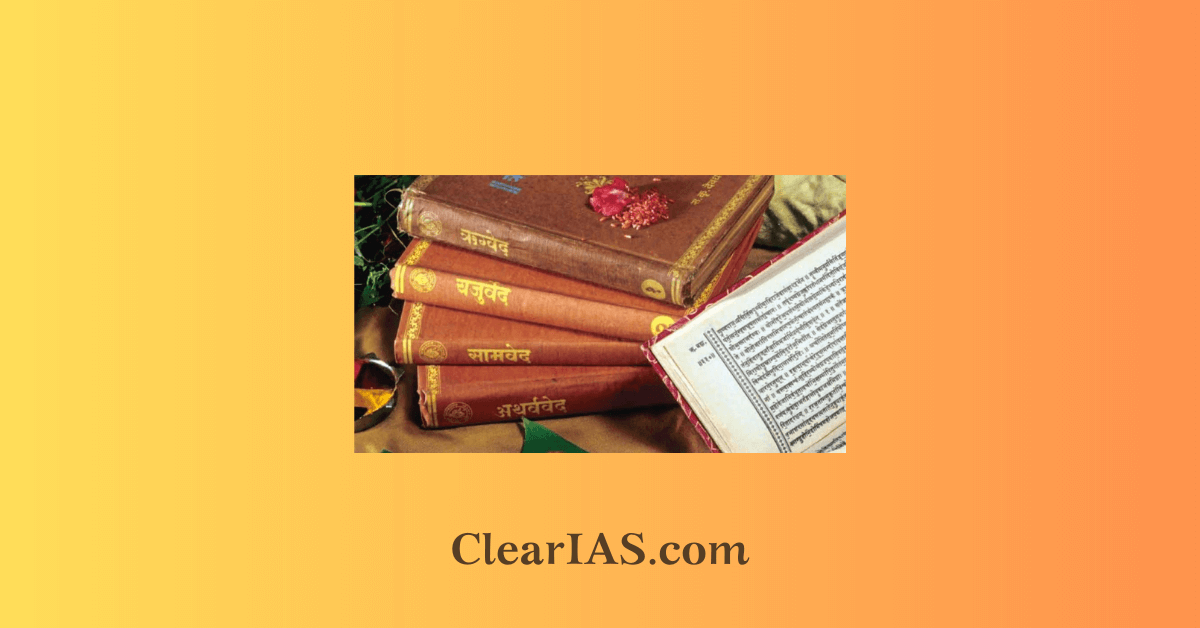
The Vedas are considered the oldest Hindu texts. The four Vedas are the best source of ancient Indian literature which originated during the Vedic age. They were orally passed on through generations before being documented. Read here to learn about the features and classification of Vedas.
The Vedas are vast collections of religious writings from ancient India that were written in Vedic Sanskrit. They are the earliest texts in both Sanskrit literature and Hinduism.
They are an important source of ancient Indian literature which originated during the Vedic age (1500-500 BCE).
‘Veda’ means knowledge and it is derived from the Sanskrit root word ‘Vid’ which means finding, knowing, or understanding.
The Vedas
The Vedas are known as ‘Shruti’ meaning ‘through hearing’, as they were handed down through generations orally with the help of elaborate mnemonic techniques.
There are four Vedas:
- The Rigveda
- The Yajurveda
- The Samaveda
- The Atharvaveda
Each Veda has four subdivisions-
- The Samhitas (mantras and benedictions)
- The Aranyakas (text on rituals, ceremonies, sacrifices, and symbolic sacrifices)
- The Brahmanas (commentaries on rituals, ceremonies, and sacrifices)
- The Upanishads (texts discussing meditation, philosophy, and spiritual knowledge).
- Some scholars add a fifth category – the Upasanas (worship).
The Vedas are shruti which is different from other religious texts which are Smriti (through remembering). The Vedic texts are authorless as well.
The various Indian philosophies have taken differing positions on the Vedas.
- The schools of Indian philosophy that acknowledge the primal authority of the Vedas are classified as “orthodox” or Astika. These philosophies include Samkhya, Nyaya, Vaisheshika, Purva Mimamsa, Vedanta, etc.
- Other sramaṇa traditions, such as Charvaka, Ajivika, Buddhism, and Jainism, which did not regard the Vedas as authorities, are referred to as “heterodox” or nastika schools.
Types and features of Vedas
There are four types of Vedas:
- The Rigveda
- The Yajurveda
- The Samaveda
- The Atharvaveda
The Rigveda, Samaveda, and Yajurveda together are known as the Vedatrayi.
Rigveda
- This is the most important and, according to scholars, oldest and largest of the Vedas.
- It is divided into ten books (called mandalas) and has 1028 hymns (suktas) in praise of various deities.
- These include Indra, Agni, Vishnu, Rudra, Varuna, and other early or “Vedic gods.”
- It also contains the famous Gayatri mantra and the prayer called the Purusha Shukta (the story of Primal Man).
- The ancient Iranian text ‘Avesta’ has similarities with Rigveda in terms of language and practices.
- Rigveda has mentioned the early Aryans as dasas and dasyus.
- Gayatri Mantra is part of Rigveda.
Rigveda manuscripts were selected for inscription in UNESCO’s Memory of the World Register in 2007.
Yajurveda
- It is a collection of mantras for use in the performance of yajnas (sacrifices).
- It is divided into two sections, the earlier Krishna Yajurveda and the more recent Shukla Yajurveda.
- It was documented around 1200-800 BCE.
- It has one of the largest Brahmana named Satapatha Brahmana.
- The important Upanishads are- Brihadaranyaka, Isha, Taittriya, Katha, Maithri.
- Brihadaranyaka is among the earliest extensive discussion on concepts of dharma, karma, and moksha.
- Katha Upanishad has the famous story of Nachiketa, son of sage Vajravasa.
Samaveda
- This consists of chants and melodies to be sung during worship and the performance of yajna.
- There are 1549 verses (except 75 verses rest have been taken from Rigveda)
- There are two Upanishads embedded in Samaveda- Chandogya Upanishad and Kena Upanishad
- Samaveda is categorized into two parts – one includes melodies called Gana (gramageya and aranyageya) and the second includes a book called Archika (purvachika and uttarachika).
- The Samaveda is considered the root of Indian classical music and dance.
Atharvaveda
- It contains hymns, mantras, and incantations, largely related to everyday life.
- It is also called the Veda of magical formulas and has 730 hymns and 6000 mantras.
- The important Upanishads are- Manduka, MAndukya, Prahsna.
- ‘Satyameva Jayate’ is borrowed from Manduka Upanishad.
- The two surviving renditions of Atharvaveda are Paippalada and the Saunakiya.
Other literature related to Vedas
There are also two important bodies of supplementary literature, related closely to the Vedas themselves. They are:
Vedangas
The Vedangas, expound the sciences required to understand and apply the Vedas.
- Kalpa (ritual detail)
- Siksha (pronunciation)
- Vyakarana (grammar)
- Nirukti (etymology)
- Chandas (meter)
- Jyotisha (astronomy/astrology)
Upavedas
The Upavedas (usually considered smriti) deal with the four traditional arts and sciences.
- Ayurveda (medicine), associated with Athrvaveda
- Gandharva-Veda (music and dance), associated with Samaveda
- Dhanur-Veda (warfare), associated with Yajurveda
- Shilpa-Veda (architecture), associated with Rigveda
-Article written by Swathi Satish






Leave a Reply